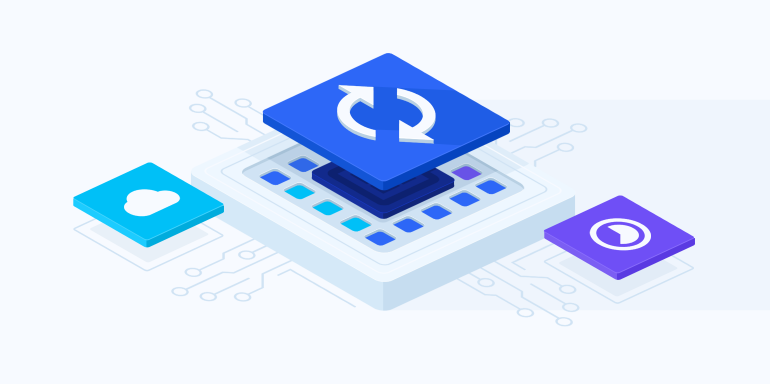Automated technologies are steadily taking over advertising. It is predicted by the year 2023 80% of the advertising process will be automated. The remaining 20% will consist of advertising elements that would always need a human connection, like brand value, storytelling, and other experiential tactics.
This makes advertising automation software an obvious choice to include in your tech stack.
Why? Because automation allows brands to have a single view of their marketing messages and makes way for more user-level data that can be connected to an advertising outcome. It helps bring about multi-channel attribution across the digital landscape.
The future of automation is bright, as it empowers digital marketers to manage and measure marketing activities, workflows, and strategies to attract customers faster leading to more business growth.
Today’s post will showcase automation trends in PPC advertising, Facebook advertising, programmatic advertising, native advertising, and landing pages.
PPC advertising automation trends
Automation helps advertisers deliver strategic input and guidance to improve their campaigns and their clients’ campaigns continuously. Since Google has the most market share with PPC advertising, let’s look at the most popular Google automation trends.
1. Automating bid management
Google increasingly encourages advertisers to use automated bidding strategies in campaigns. Specifically, its advanced machine learning technology can amend bids based on a wide range of real-time signals such as device, location, time of day, remarketing list, language, and operating system.
Advertisers can use the following smart bidding strategies when they reach the minimum conversion requirements within 30 days:

For instance, if you select Target CPA, you set a specific number that you want to spend to acquire a customer. Google then uses machine learning to optimize your bidding. It can lower bids when users aren’t ready to convert or increase bids when a user is highly motivated and ready to buy.
2. Automating ad copy
Writing ad copy for multiple ad campaigns is time-consuming. Fortunately, you can automate ad copy creation:
- Google’s dynamic search ads (DSAs) allow advertisers to automatically target and generate ads based on their website content.
- Google recommends creating ads using Google Scripts rather than using DSAs. However, you will need to have an up to date product data feed and in-depth knowledge of Google sheets to use this technique.
3. Automating PPC reporting
Google Analytics add-on for Spreadsheets makes it easier to access, visualize, share, and manipulate your data in Google Spreadsheets. You’ll be able to pull in selected metrics and dimensions and customize the visualization of your data using Google sheets charting functionality.
You can also automate your PPC reporting by:
- Setting up and automating custom reports in Google Analytics
- Setting up PPC dashboards in Data Studio
What’s more, with the Instaspage Advertising Attribution Solution, customers have full visibility into paid advertising attribution across the entire marketing and sales funnel. Enterprise users can also track cost-per-visitor and cost-per-lead for paid and organic traffic — data no other post-click landing page solution can provide:
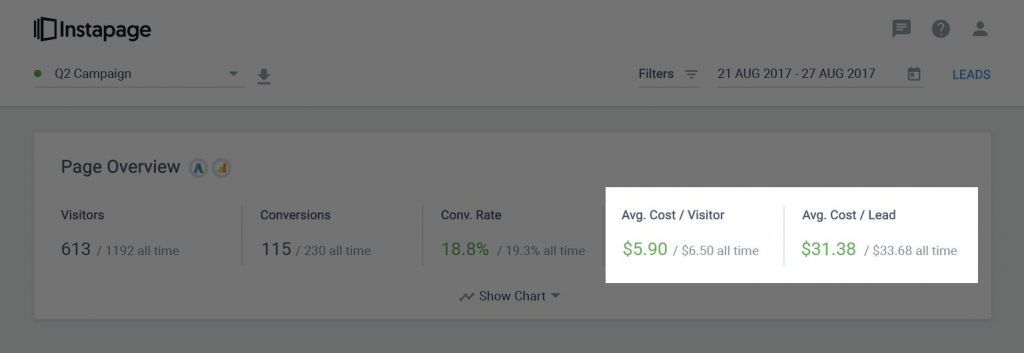
Automating PPC reporting helps you save countless hours trying to create reports that help with business growth. Conversely, you could reallocate that time to other tasks like looking at keyword opportunities, tracking test results, and overseeing ad copy reviews.
4. Use automated rules
Automated rules allow you to schedule your ads to appear at specific times of the day, adjust bids by the time of day, seasonal factors or other dynamic conditions, or control your budget and costs.
You can use automated rules to:
- Pause low performing ads or keywords
- Adjust bids for keywords based on cost per conversion
PPC automation helps advertisers save time and increase efficiency by allowing them to put their focus on other tasks that require a human connection.
Facebook advertising automation trends
Facebook Advertising provides advertisers with incredible reach to find, engage with, and influence their target audience. Perhaps why Facebook gets the biggest share of social media advertising dollars in the world. Video ad revenues alone have steadily climbed in recent years and doesn’t appear to be slowing down:
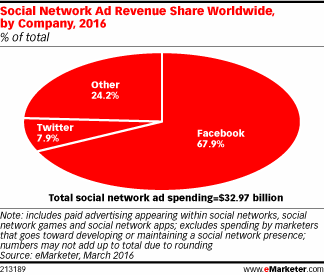
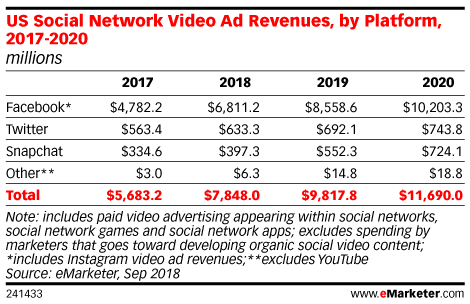
The Facebook Ad Manager offers multiple features to help advertisers create highly targeted campaigns and deliver results. However, you can only do this by acquiring the right expertise and staying up-to-date on new features of campaign creation.
Automation changes this.
To allow advertisers to forgo continuous optimization and monitoring tasks, Facebook launched Automated Rules.
These rules automatically check your campaigns, ad sets, and ads for the rules you identify, and then update or notify you of any changes. Along with the automatic checks and notifications, the tool also takes necessary actions for you.
When you create an automated rule, you choose:
- The criteria that triggers the rule
- The action your rule takes on the ad
- The active campaign, ad set, or ad you want the rule to affect
Automated rules help you manage multiple ads you’re running at the same time. Think about the items you frequently check up on and the subsequent actions you take in Ads Manager.
For example, do you?
- Pause a low-performing ad when it hits a specific metric
- Increase your budget when a certain number of users click your ad
- Increase your bid if the total daily spend is below a certain amount
- Increase budget based on return on ad spend (ROAS)?
- Turn off a specific campaign on a specific day of the week
Fortunately, you can create an automated rule for all of the above situations.
There are four types of Facebook Ads Automation available:
- Performance Alerts: Get an email alert with a list of the affected campaigns, ad sets, or ad creative that are experiencing positive or negative performance trends. These trends could be high/low CTRs, budget spend, or Cost Per Conversion.
- Ad Set Scheduling: Ad performance can vary on different days of the week and even during different hours in a day. Choose to show ads in peak performance hours as opposed to running evergreen ad sets since this keeps your cost per conversion trends low.
- Optimization Rules: Determine the conditions when you would like technology to make optimizations on your behalf. For example, you can create a rule that goes through all your active ad creative within a campaign and pauses ads with high cost per conversion trends.
- Ad Creative Testing: This includes multivariate testing, ad flighting, and ad rotation rules. Multivariate testing lets you test different headlines, description copy, images, CTAs, and destination links. Ad flighting/sequencing helps you group, align, and schedule clusters of ads that are triggered based on performance or time duration. Whereas, ad rotation rules rotate multiple ad creatives based on performance or time duration, without a specific order.
Facebook Automated Rules allow marketers to automate the customization of their ad campaigns, so they have to put in less effort while reaping higher rewards.
Programmatic advertising automation trends
Programmatic advertising, also known as “programmatic marketing” or “programmatic media buying,” is the process of purchasing ad space via software, and relying on complex algorithms to deliver advertisements contextually.
By the year 2021, almost 88% of all US ad dollars will be spent on programmatic advertising. Investments in video, native, and mobile will propel its growth:
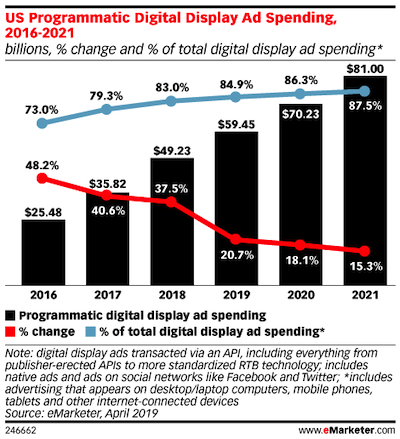
Before programmatic advertising came into existence, ad space was bought and sold by humans, specifically two parties — the advertiser and the publisher. This made the process slow and inefficient because it took Request For Proposals (RFP), meetings, and negotiations before an ad was published. Publishers would promise advertisers a set number of impressions to a particular target audience, and advertisers would buy the ad space if the target audience was one of their buyer personas.
This method worked until the number of publishers increased at a pace advertisers couldn’t keep up with. Ad space supply became much higher than the demand and it wasn’t uncommon for 40-60% of publisher inventory to go unsold.
This was when programmatic advertising automation came into existence. Automation in the programmatic space means:
- Cutting out the middleman to streamline the ad buying process
- Serving more relevant ads by targeting demographics and context rather than inventory
- Access to a greater pool of publishers
- Efficiently measuring their return on investment
Today, AI assists with programmatic auctions and dynamic creative optimization, allowing publishers and advertisers to be more creative and productive.
Automation is used in remarketing and lookalike modeling to connect the most relevant audiences — improving personalization. This also allows media buying to predict the likelihood of a customer responding to an ad and bidding on that opportunity accordingly.
The data-driven approach to automation and machine learning enables advertisers to convey the right message at the right time to the right audience.
Native advertising automation trends
Native advertising showcases paid ads that match the look, feel, and function of the media format in which they appear, making them look native to their environment.
We have already established how automation makes the media buying process more efficient by reducing the amount of time it takes to buy and sell placements. This automation trend also applies to native advertising.
Running native ads programmatically allows you to get the benefits of programmatic display automated media buying, effective targeting, and audience insights for further optimization.
A 2016 Think With Google report detailed that when “The New York Times introduced flex Frames” native format, “click-through rates increased 6x compared to equivalent banner ads, and viewable impressions increased 4x.”
So, using native ads in combination with automated programmatic advertising helps you achieve higher CTR and increased business growth.
Post-click automation trends
Post-click automation (PCA) is the category of marketing technology that enables marketers to maximize advertising conversions by automating the post-click stage in the advertising funnel. This is accomplished by delivering 1:1 personalized experiences at scale.
Automating post-click landing pages allows you to increase conversions for your advertising campaigns at the right stage of the funnel:

Ad mapping is a post-click automation trend that enables marketers to focus more on strategy and less on mundane, repetitive daily tasks.
Currently, PPC marketers have to download campaign information to spreadsheets and map their ads to post-click landing pages manually. The entire process is lengthy and makes it highly challenging to determine the number of experiences needed per campaign, to log the updates made to each, and keep message match consistent between each ad and page.
The right PCA platform allows marketers to visualize the advertising funnel and give them the ability to connect ad networks to specific page experiences.
Using automation to personalize post-click landing pages helps create tailored messages for every audience segment, which generates more conversions. After all, it’s an optimized experience from start to finish, which makes the advertising conversion likely to occur.
Automation takes the effort out of advertising
Advertising automation is a trend you can’t afford to ignore. Automated technologies make it easier to optimize your online ads to create a positive impact on ad campaigns by increasing CTR or reducing your CPC.
When automation is combined with intelligent user data, it helps engage prospects and customers. Using relevant ad content helps you successfully convert those prospects and increase advertising conversions regardless of the advertising platform and the ad type.
See how post-click automation can be your biggest difference-maker with ad campaigns with the new guide here.
